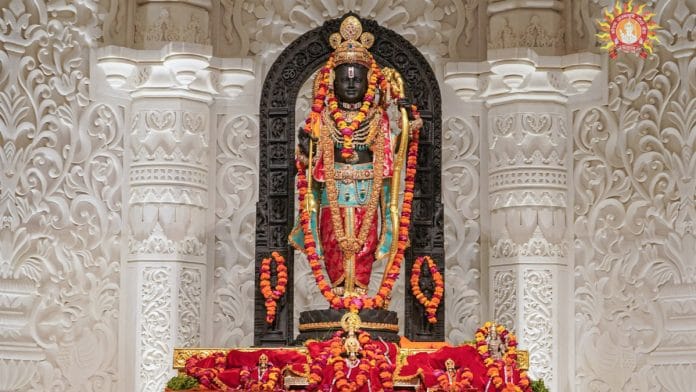Thank you dear subscribers, we are overwhelmed with your response.
Your Turn is a unique section from ThePrint featuring points of view from its subscribers. If you are a subscriber, have a point of view, please send it to us. If not, do subscribe here: https://englishdev.theprint.in/subscribe/
It is a beautiful temple. The deity with the childlike face and gentle smile is beneficent and serene. And people are delighted! The nation appears immersed in devotion. A few aggressive shobha yatras skirmishes and bulldozer justice or the saffron flags atop Christian prayer halls were reported, but things have been largely peaceful.
The people I know who are delighted about the inauguration of the Ram temple at Ayodhya, are mostly lovely people. They are my friends, relatives, social media friends. They are good to neighbours, kind to stray animals, helpful to the needy, devoted to their families and respectful of their subordinates. Just all round decent humans. Like them, I want to be happy about the mandir. So why do I have so many misgivings?
The politics
This isn’t about me being an atheist – or maybe it is a bit. I view all organised religions with some unease. Historically as well, mixing religion and politics has not worked out well. Iran, Pakistan, Sri Lanka are just some examples of how important aspects of public life take a back seat when religion occupies centre stage in the political landscape.
So when the new parliament is inaugurated with much religious pomp this makes me uneasy. More recently we saw visuals of the Prime Minister visiting temples across the country. We heard about him fasting and undertaking other religious rituals in the run-up to the temple inauguration. While every individual is free to profess their religion, the overt public display by a head of state is unseemly. Plus, we cannot dismiss the electoral benefit that will undoubtedly accrue to the ruling party following this grand show. So, when religion and religiosity become overtly political, this queers the pitch – it should be a matter of concern for all of us.
The apotheosis
In the days leading up to the temple inauguration, we saw how the Prime Minister was sought to be equated to an Avatar himself. At the temple inauguration, the Prime Minister was the central focus. The deity seemed almost incidental. To me, the temple consecration seemed to bear a striking resemblance to a coronation. The solemn, kingly bearing of an elected representative made the democrat in me exceedingly anxious. The who’s who of the country: captains of industry, entertainers and other celebrities were all in attendance and they all appeared to be cheering on what seemed to be a divine elevation.
Majoritarian isn’t the same as democratic
Populism is dangerous – we have seen in repeatedly. Saying that what is happening is because the people want it, is cop out. A democracy is best defined by the way it treats its minorities, as people far wiser than me have observed. In recent times unfortunately we have seen the opposite. Minorities, particularly Muslims have been made to feel as though they do not matter, as though they are lesser citizens of the country. The ruling party has repeatedly asserted that they don’t need the Muslim vote. The community is significantly underrepresented politically.
Understanding the demographic shifts is crucial, especially when we consider how the Muslim population has increased in recent decades, reflecting broader societal changes.
Recently the colour saffron has been appropriated and misused in some threatening ways. So when there are saffron flags lining the roads and inside the housing society I live in, I feel a sense of disquiet.
The amnesia
We all seem to have forgotten how we got here. The fact is that thirty years ago, an ancient structure was razed to the ground in a brazen, criminal act and there were no consequences for those responsible. This has receded from public memory it would seem. An event the iconic India Today magazine cover had called a ‘National Shame’ has now been forgotten; almost sanitised.
A 500-year-old violation is now foregrounded over one from living memory. There is no conciliatory note struck at this victorious moment. The temple has come up in record time, but no such alacrity was shown for the building of the mosque as directed by the Supreme Court.
The erasure of Sita
It used to be Jay Siya Ram, now it is Jay Shree Ram. While Lord Ram is traditionally accompanied by Sita and Laxman in most iconography, this has changed in recent times. The temple consecration ceremony was also marked by a complete absence of women. The men spoke and the men acted. The women were invisible.
So, I do, truly want to be happy about the Ram Temple, I want to be able to rejoice as so many around me are, but there are all these pesky misgivings of mine…
Meanwhile today, the saffron flags in the housing society have been replaced with tricolours – and already, some of those misgivings are allayed. I am struck anew by how much I love this crazy, chaotic, contrary, splendid country of mine.
These pieces are being published as they have been received – they have not been edited/fact-checked by ThePrint.


